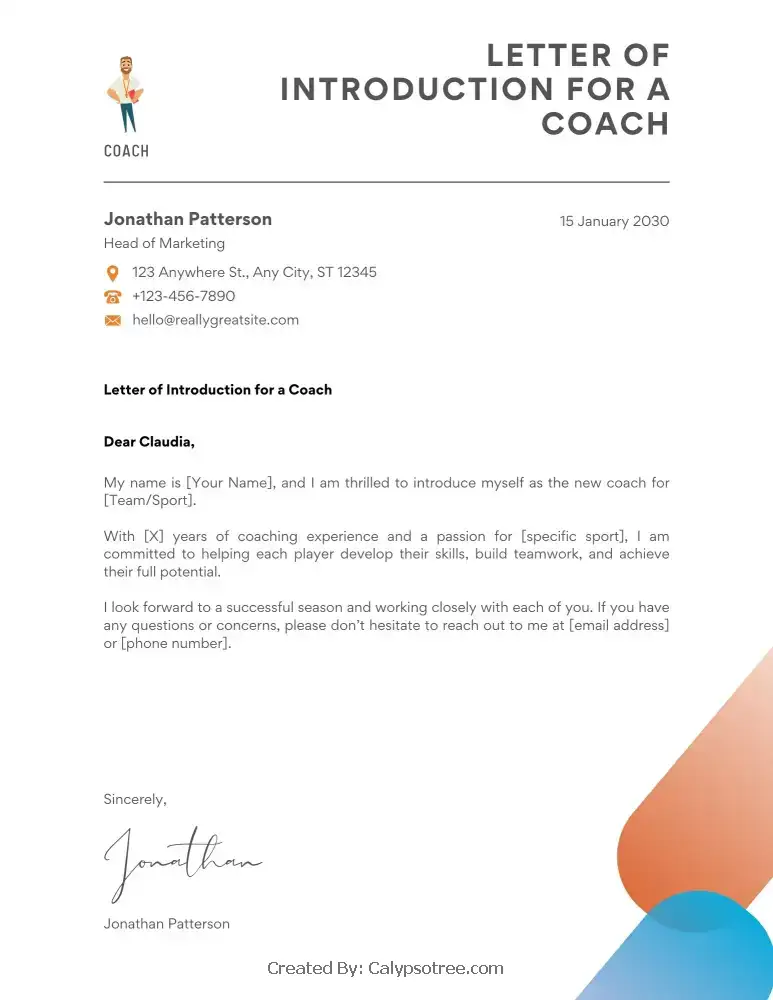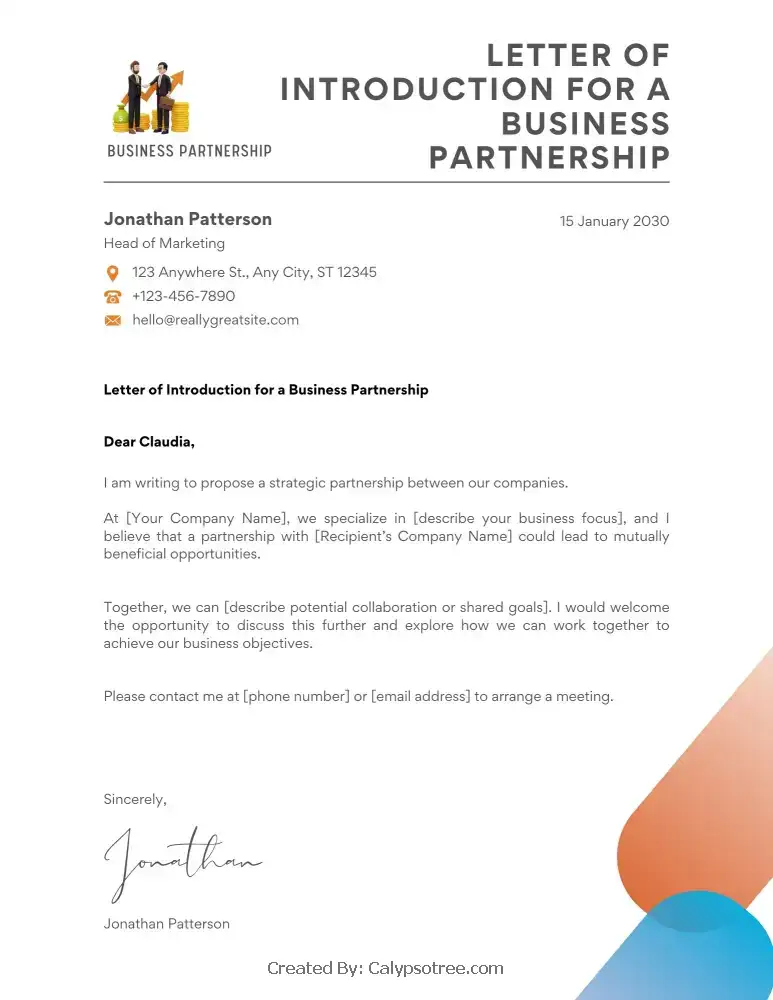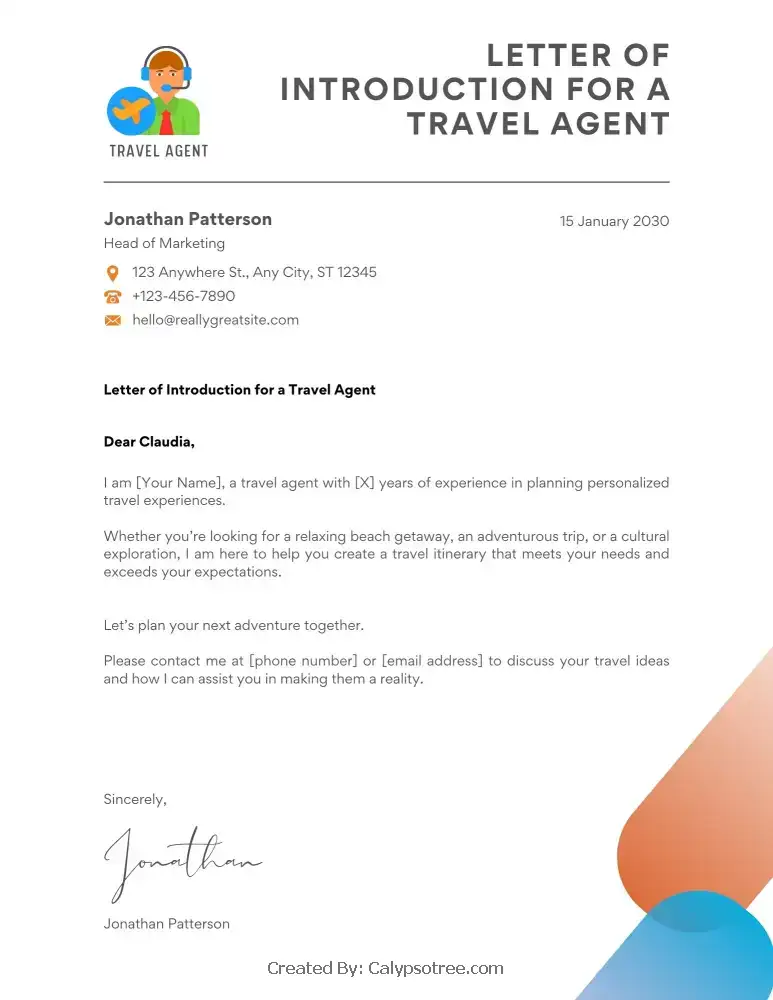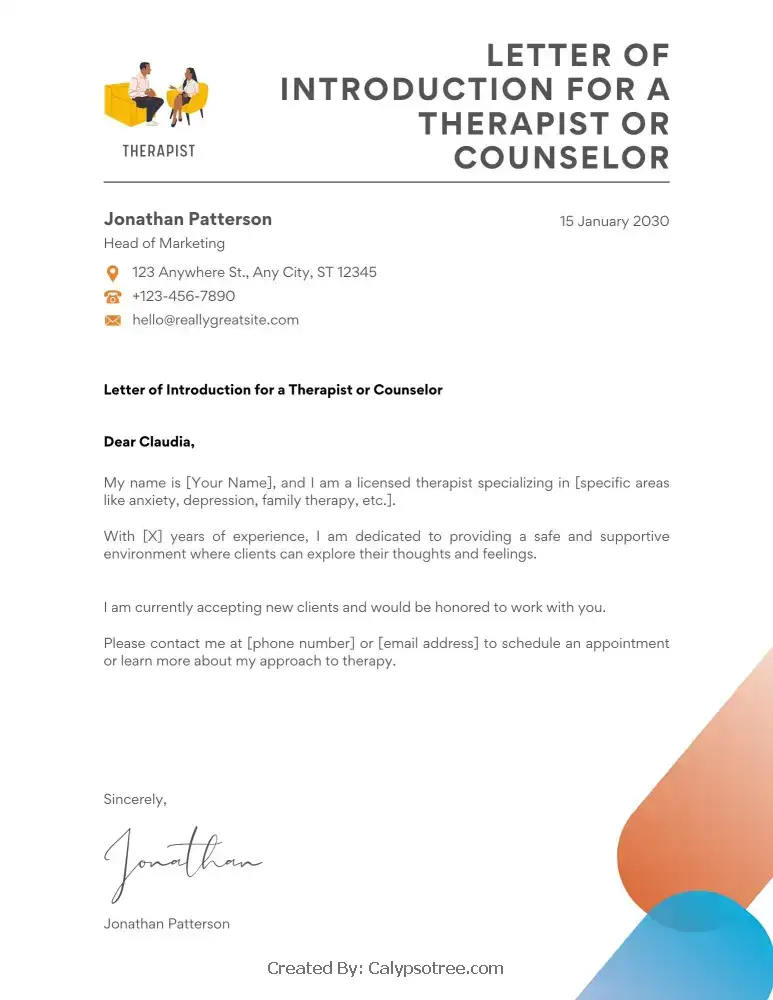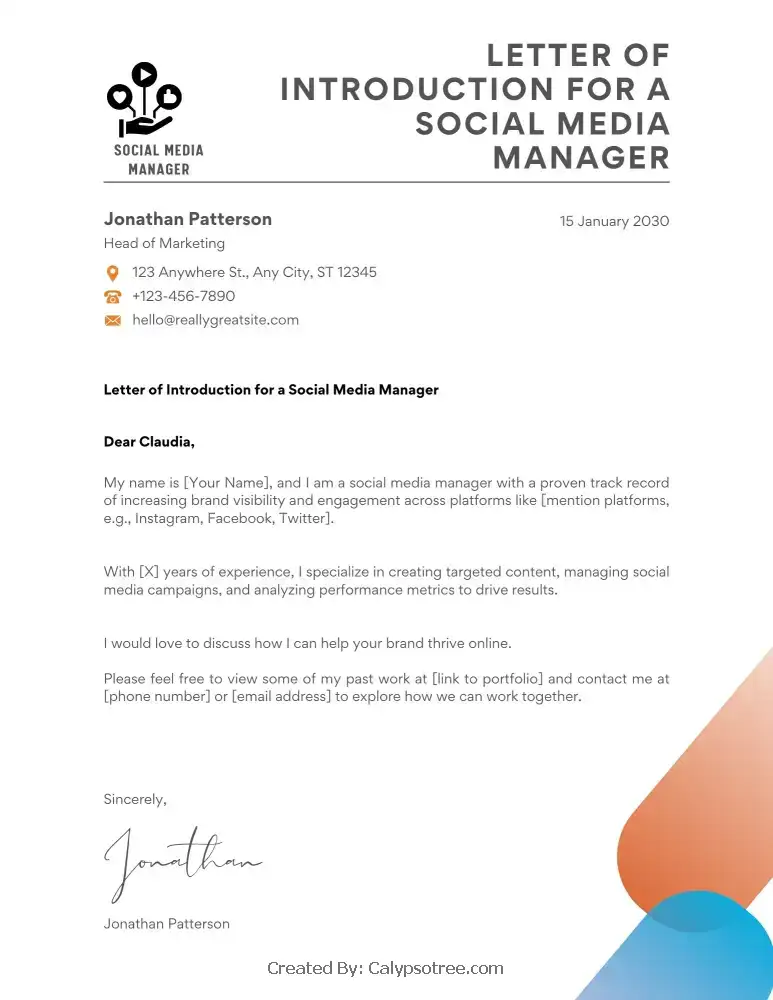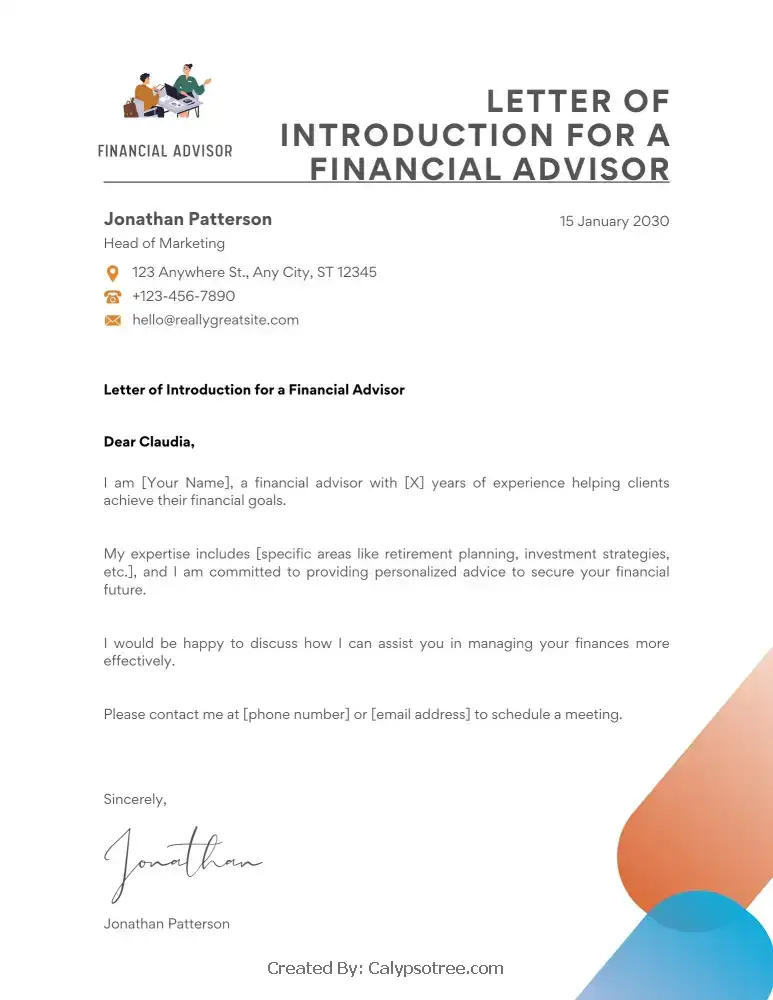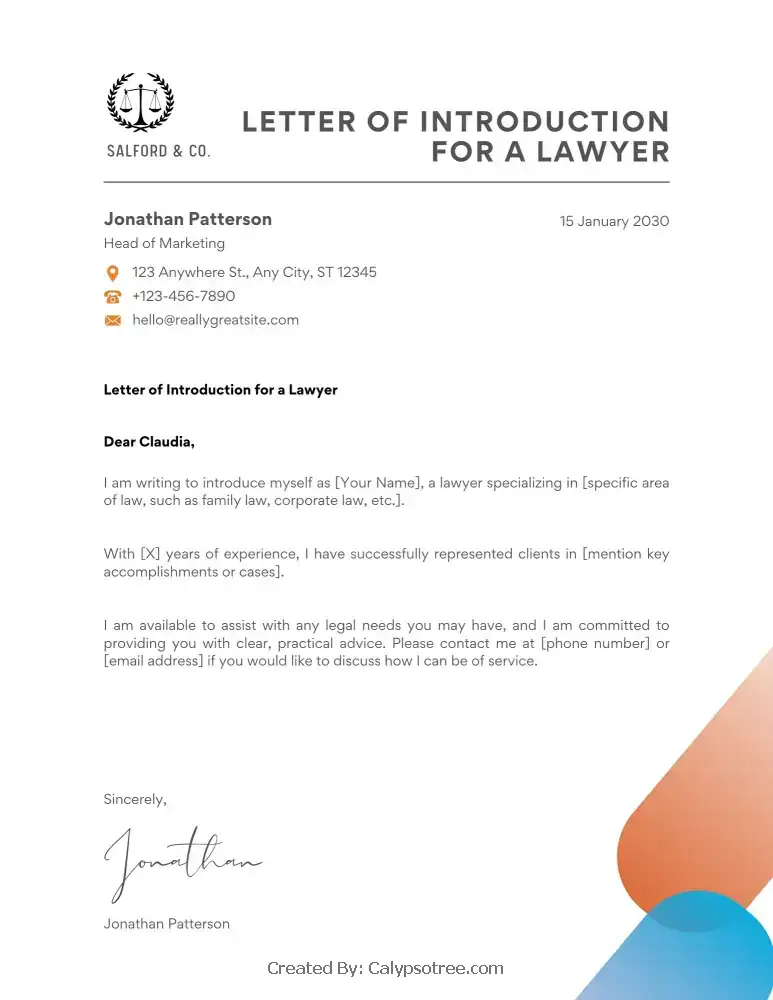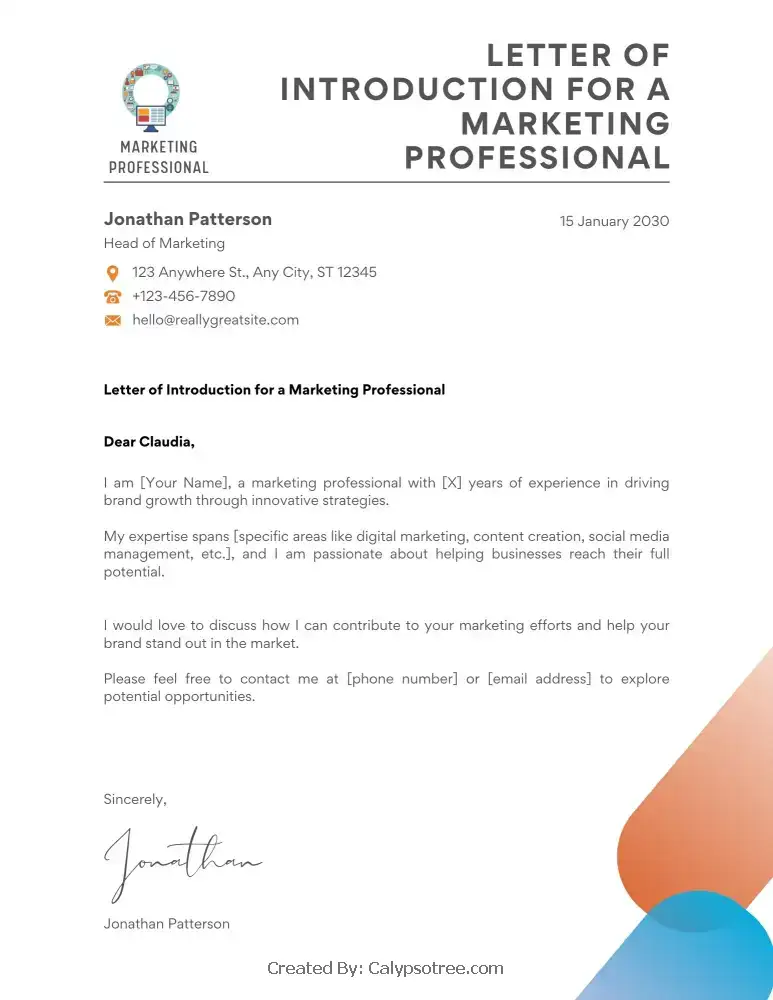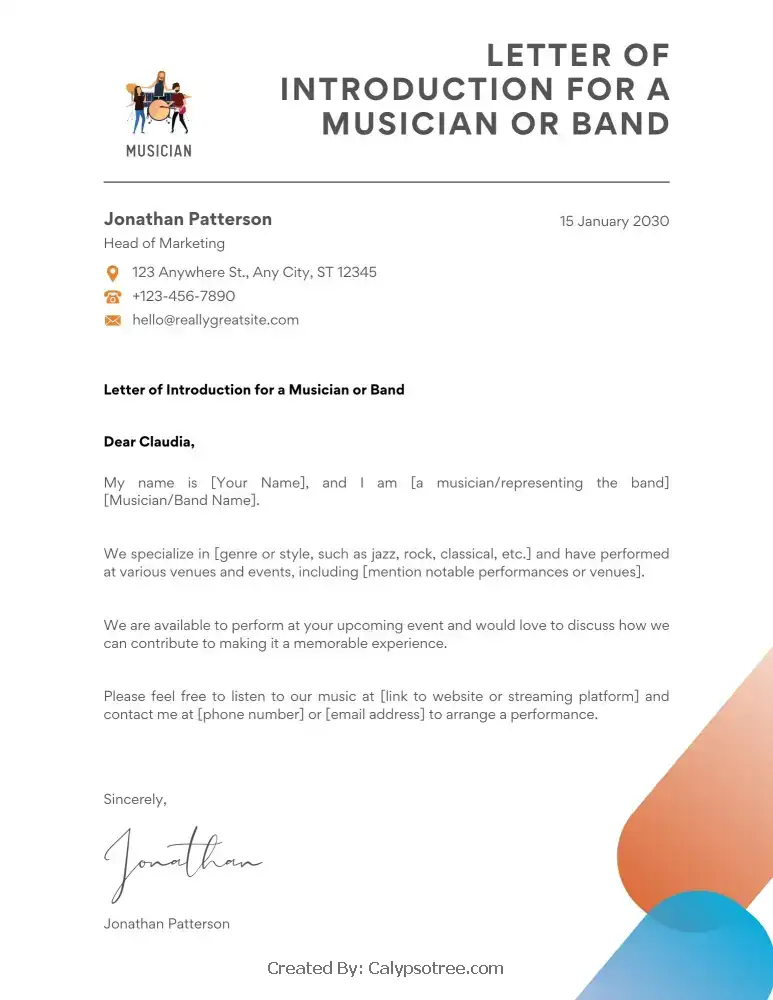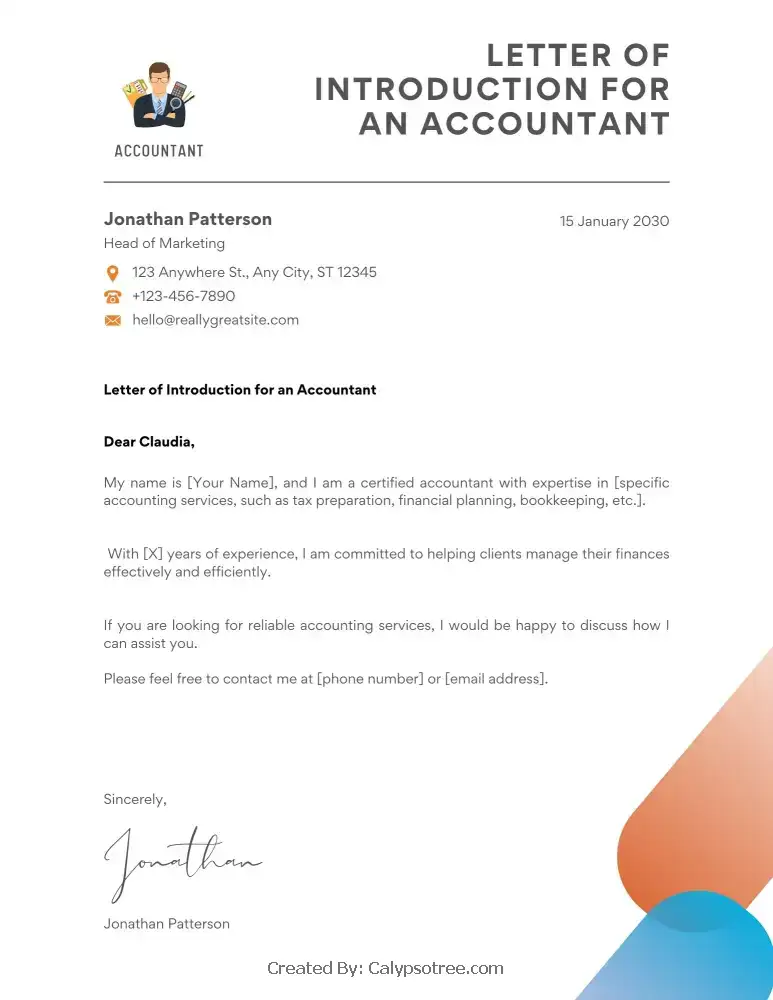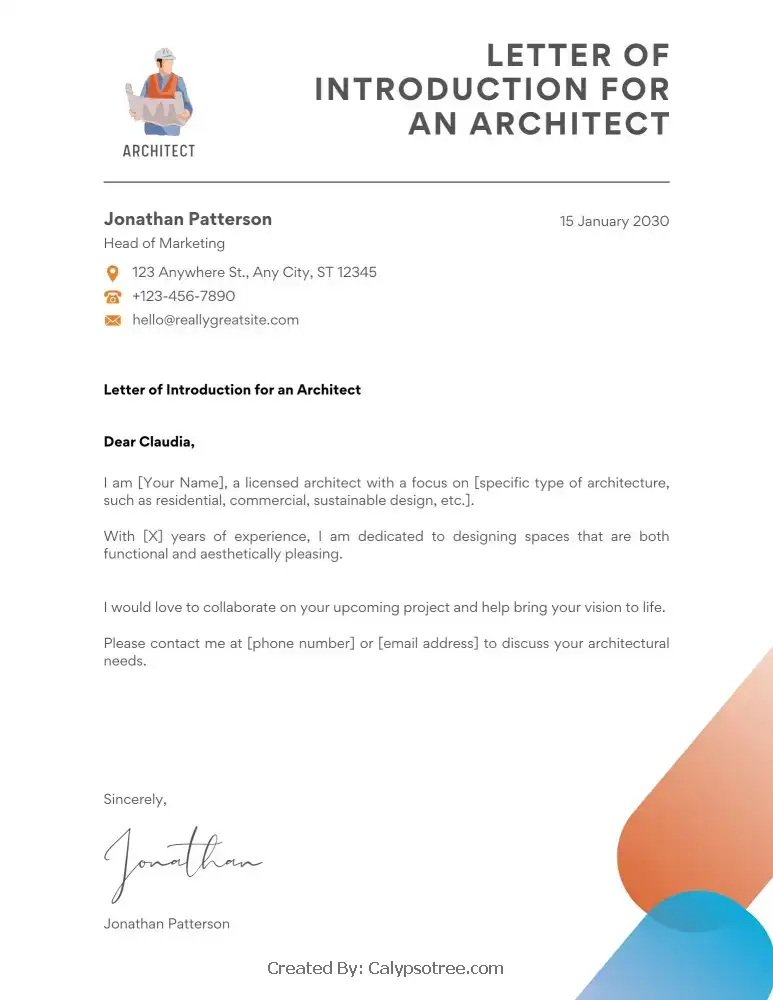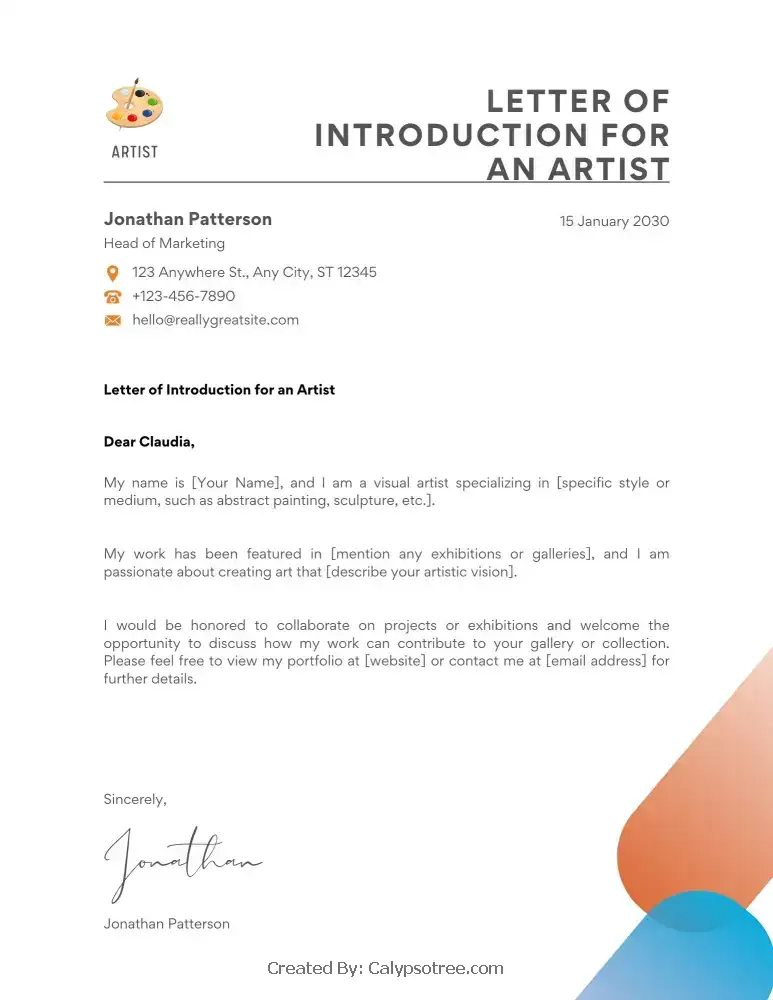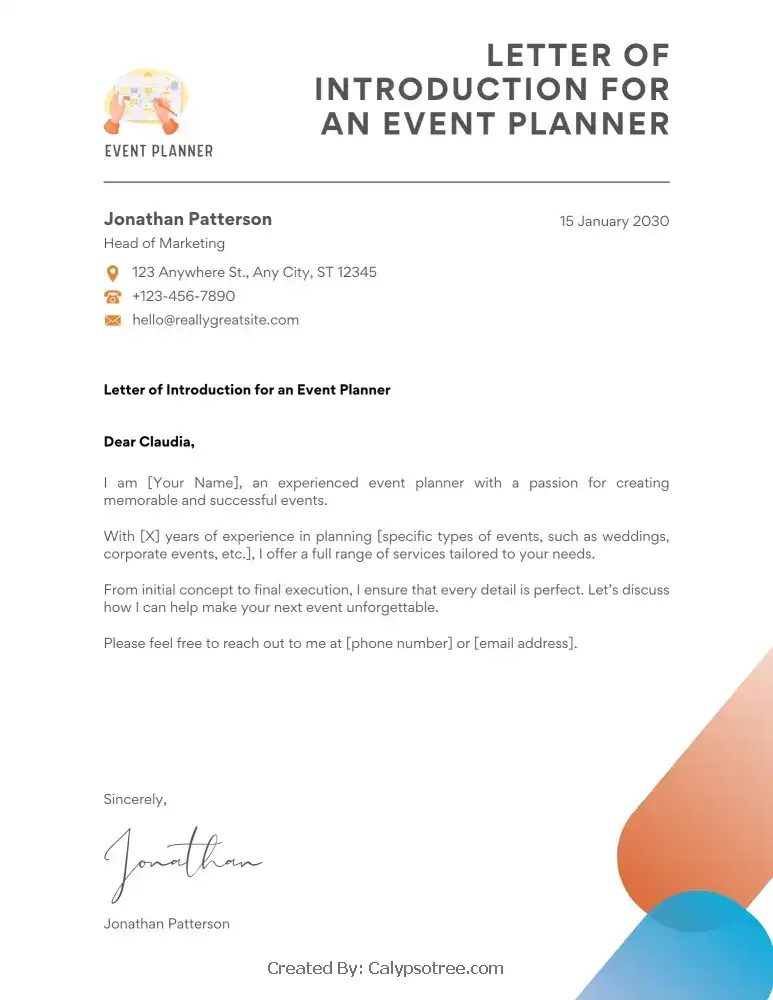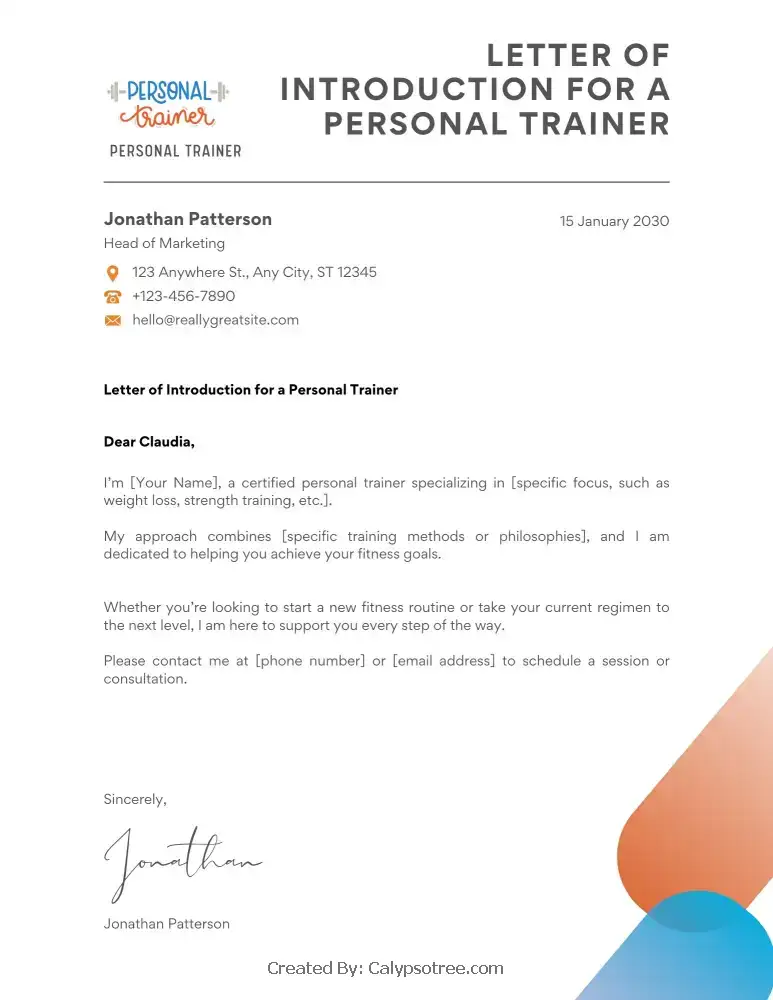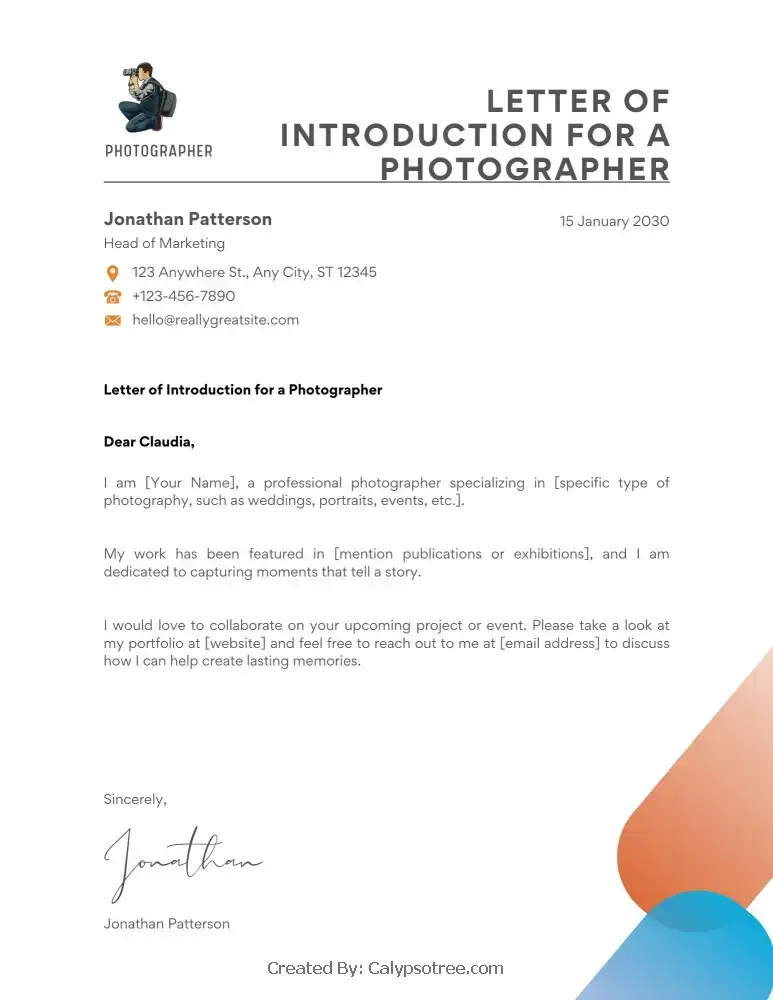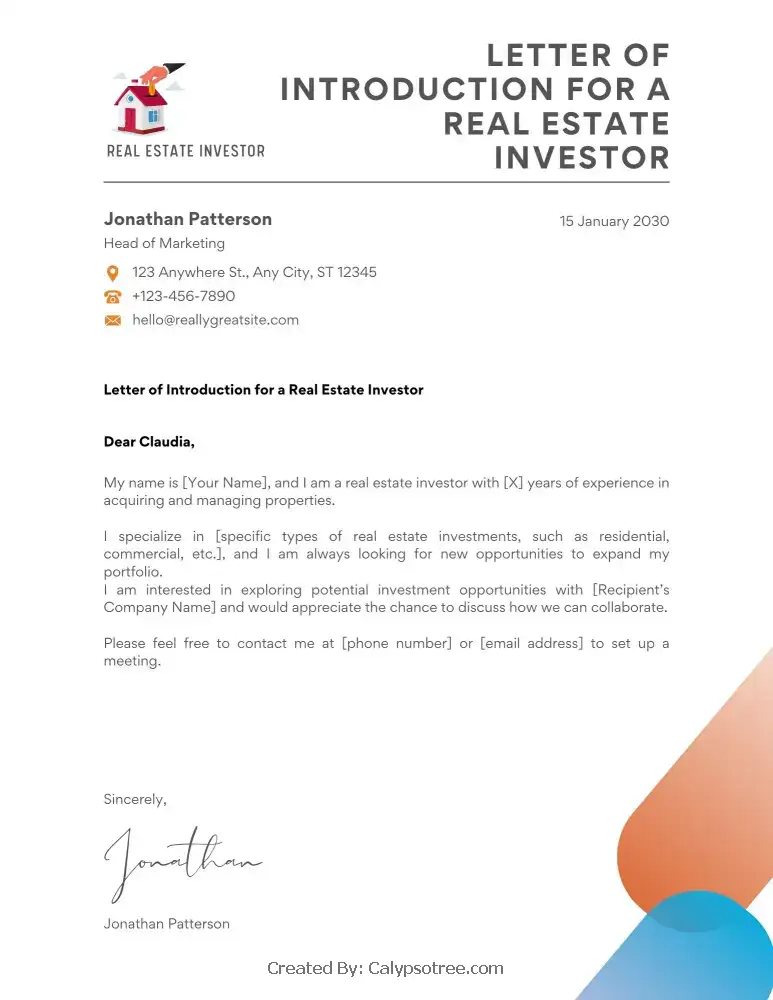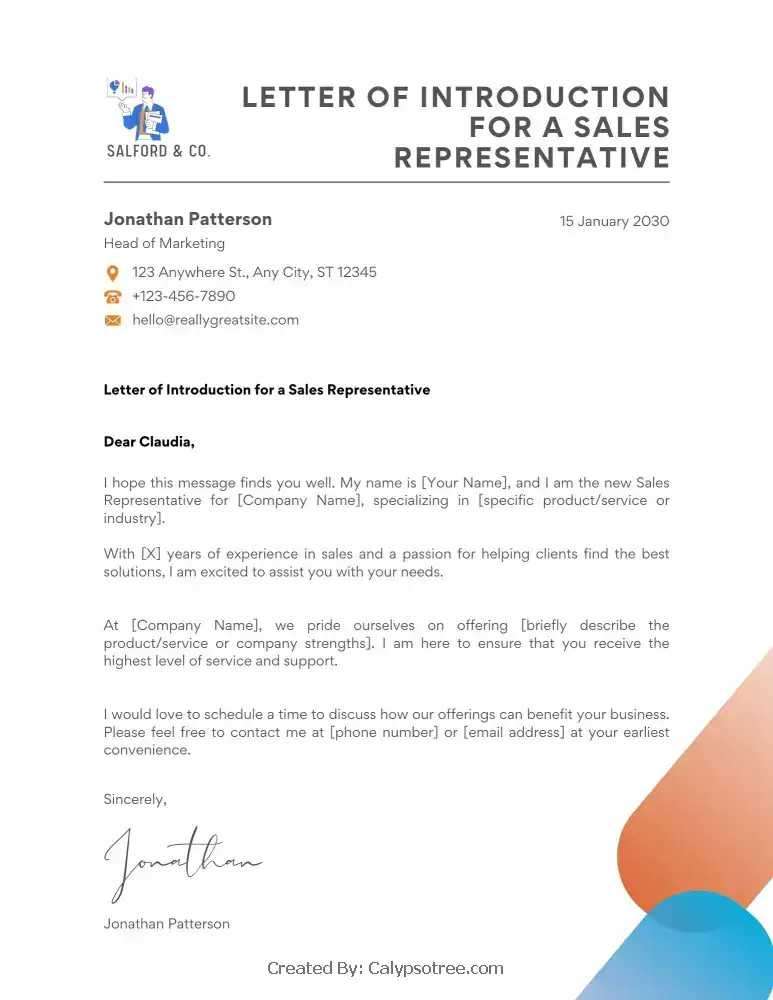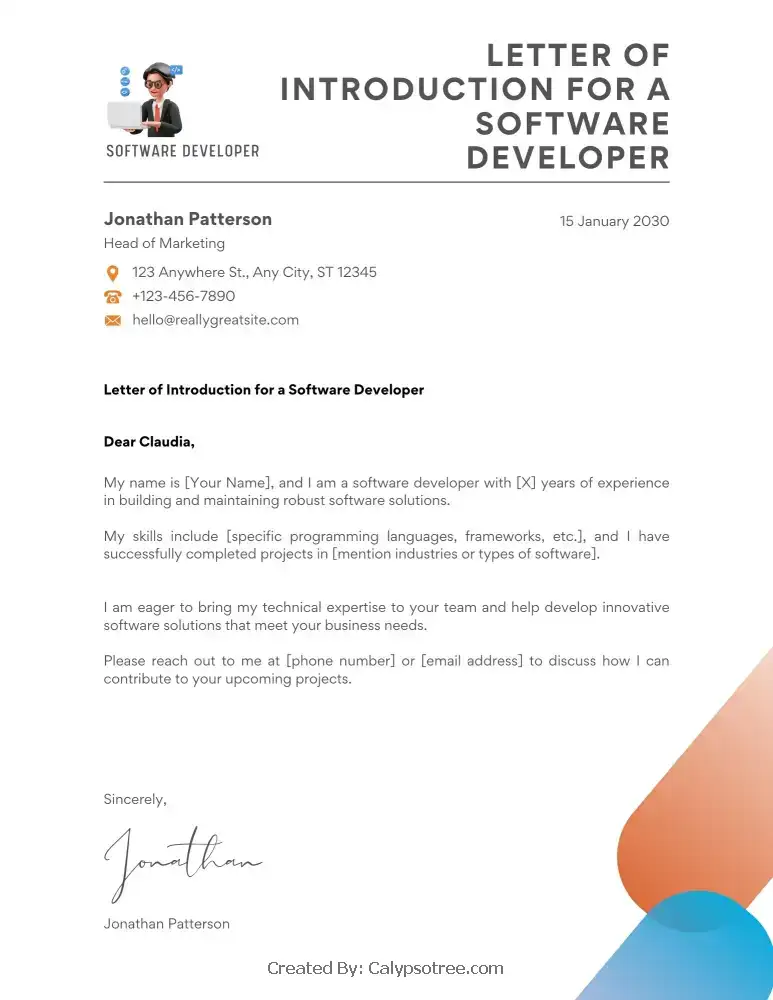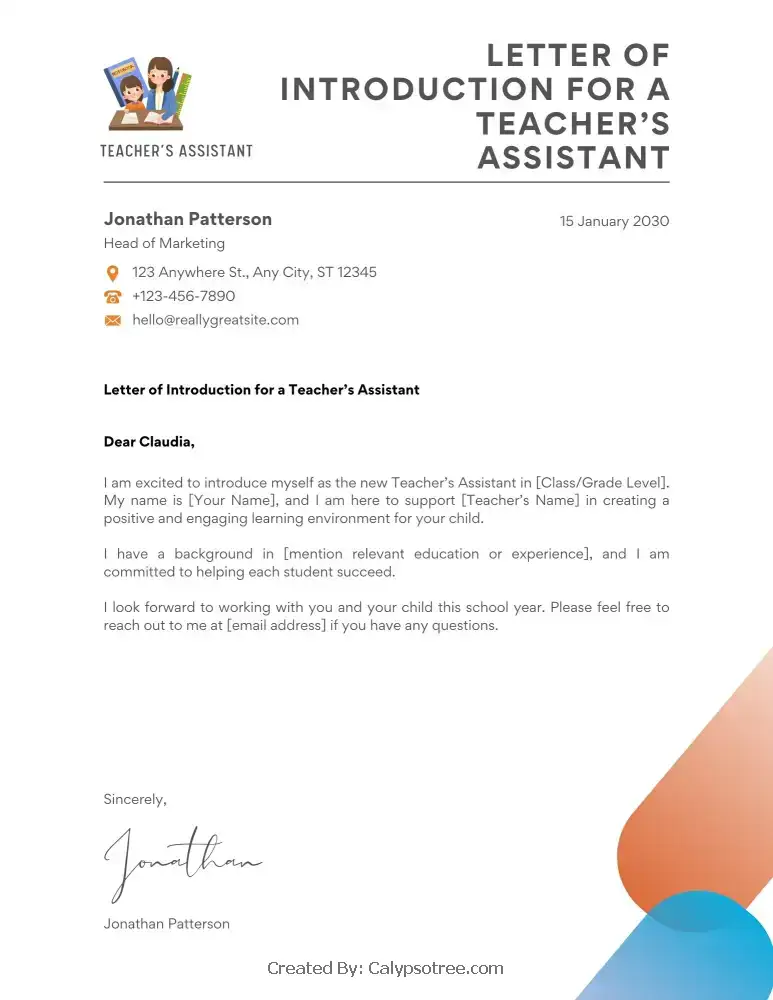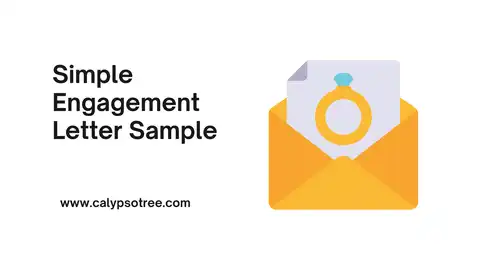A letter of introduction is a document used to introduce one person to another or an organization. It helps establish a connection between people who may not know each other.
A letter of introduction is a handy way to connect people or introduce someone to an organization. This type of letter can be used in various situations.
What Should Be Included in the Letter of Introduction?
Be sure to include these key sections:
Header: Start with your name, address, phone number, and the date at the top of the letter.
Recipient’s Details: Write the name, job title, company, and address of the person you’re addressing.
Salutation: Use a courteous greeting, such as “Dear Mr. Smith” or “Hello Ms. Johnson.” If you aren’t sure what the name is, write “Dear Sir or Madam.”
Introduction: Introduce yourself and explain your connection to the person you introduce. For instance, “I am Jane Doe, and I work with John Smith at XYZ Company.”
Purpose of the Letter: Clearly explain why you are writing. Mention that you are making an introduction and why it matters. For example, “I am writing to introduce you to John Smith, who is a skilled software developer.”
Main Content: Share more information about the person you are introducing. Include their skills, experience, and other relevant details. Explain how this introduction could be helpful.
Offer of Assistance: Let the recipient know you can provide more details.
Closing: Conclude with a respectful closing like “Sincerely,” “Best regards,” or “Yours truly.” Add your name and signature, or type your name if the letter is being emailed.
Who Can Write a Letter of Introduction?
It is a flexible tool that almost anyone can write. Whether for work or personal reasons, this letter helps people connect. Here’s a closer look at who can write it:
Individuals Introducing Themselves
You can write a letter to introduce yourself to someone new. This could be a potential employer, a business partner, or someone you want to network with. In the letter, you would explain who you are, why you’re reaching out, and what you hope to achieve by making this connection.
Employers Introducing a New Employee
Employers often write letters to introduce new employees to clients, colleagues, or other stakeholders. This letter helps the new employee feel welcomed and provides important background information about the people they will work with.
Colleagues or Friends Making a Professional Connection
You can write a letter on their behalf if you know someone who would benefit from meeting another professional. For example, if you have a friend looking for a job and know someone hiring, you can write a letter to introduce your friend to the hiring manager. This helps create a connection that might not have happened otherwise.
Businesses Introducing Themselves to Potential Clients
Businesses can write letters introducing their services or products to potential clients or partners. This letter helps start a relationship and can be the first step in building a business connection.
Nonprofit Organizations Introducing Themselves to Donors or Volunteers
Nonprofits often write letters to reach potential donors, volunteers, or community members.
Teachers or School Administrators Introducing Themselves
Teachers and school administrators might write letters to introduce themselves to students, parents, or the community.
Professionals Introducing a New Service or Product
If you are a professional, such as a consultant, lawyer, or doctor, write a letter to inform potential clients about a new service or product you are offering.
Letter of Introduction Templates
When to Use a Letter of Introduction
Here’s a look at some expected times you might want to use it.
Job Applications
When applying for a job, it can help you stand out. This letter can introduce you to a potential employer before they even see your resume.
It gives you a chance to make a positive first impression by explaining who you are and why you’re interested in the job.
A well-written letter shows you’re serious about the position and eager to learn more about the company.
Networking
Networking is all about making connections with people in your field or industry. It can help you reach out to someone you’ve never met but would like to know.
Business Introductions
In the business world, it’s common to introduce new employees or business partners to clients or other team members.
It is a great way to do this. It allows you to introduce the new person formally, share a bit about their background, and explain what role they will play in the company.
Personal Introductions
Sometimes, you should introduce a friend or family member to someone who can help them with their career or personal goals.
It can make this process smoother. For example, if your friend is looking for a job, you can write a letter to introduce them to a potential employer.
Introducing Yourself in a New Community
If you’ve moved to a new area or are joining a new community, It can help you get to know people. You can use the letter to introduce yourself to neighbors, community leaders, or groups you want to join.
Introducing a New Product or Service
When a business launches a new product or service, It can be a powerful marketing tool. The letter can introduce the latest offering to customers or clients, explaining its benefits and how it can meet their needs.
How to Create a Professional Letter of Introduction
Follow these simple steps:
- Start with a Greeting: Begin with a polite greeting, such as “Dear Mr. Smith” or “Hello Ms. Johnson.” If you don’t know the name, use “Dear Sir or Madam” or “To Whom It May Concern.”
- Introduce Yourself: In the first paragraph, introduce yourself. For example, “My name is Jane Doe, and I work with John Smith at XYZ Company.”
- State the Purpose: Clearly explain why you are writing. Mention that you are introducing someone and why this introduction matters.
- Provide Background Info: Share some background about the person you introduce, like their skills or experience. For example, “John has over 10 years of experience in software development and has led many successful projects at XYZ Company.”
- Highlight the Benefits: Explain how the person you’re introducing can help the reader or how they might work well together.
- Offer Further Assistance: Let the reader know you’re available if they need more information or want to discuss further. For example, “Feel free to contact me if you have any questions or want to learn more about John.”
- Close the Letter: End with a polite closing like “Sincerely,” “Best regards,” or “Yours truly.” Sign your name or type it if sending electronically.
- Review and Edit: Before sending, review your letter for any spelling or grammar mistakes to ensure it’s clear and easy to read.
Letter of Introduction Examples
How to Use a Letter of Introduction Effectively
Here are some tips to help you use a letter of introduction effectively:
- Personalize the Letter: Even if you use a template, personalize each letter for the person or company you are sending it to. Mention specific details that show you have thought about the recipient. For example, refer to a recent project they worked on or a shared connection.
- Be Clear and Concise: Keep your letter clear and to the point. Avoid long paragraphs and unnecessary details. The goal is to make the introduction simple and easy to understand. Stick to the main points and ensure the reader knows why you are writing and what you want them to do next.
- Highlight the Benefits: Explain why the introduction benefits the recipient. This could be in terms of skills, experience, or opportunities. For example, you could say, “I believe John’s expertise in software development will be a valuable asset to your team.” This helps the reader see the value in the introduction.
- Follow-Up: It’s a good idea to follow up with a phone call or email after sending the letter. This shows you are serious about the introduction and willing to support it further. A follow-up also allows the recipient to ask any questions they might have.
- Be Professional: Keep the tone of your letter professional and respectful. Use polite language and avoid casual phrases. Even if you know the recipient well, it’s important to maintain a level of formality in the letter.
- Check for Mistakes: Before sending your letter, take a moment to proofread it. Look for spelling or grammar errors, and make sure the letter is easy to read. A well-written letter makes a better impression and shows you care about the introduction.
- Use the Right Format: Make sure it is formatted correctly, whether you send the letter by email or as a printed document. For emails, use a clear subject line like “Introduction of John Smith.” Ensure printed letters are neatly typed and include all necessary contact information.
Tip: Always keep a copy of the letter for your records. This can be useful if you need to refer back to it later or if you need to resend it.
Professional Letter of Introduction Templates & Examples
Here is a professional letter of introduction:
Letter of Introduction for a Teacher
This type of letter introduces a teacher to students, parents, or colleagues. It usually includes the teacher’s qualifications, teaching style, and what they plan to bring to the classroom.
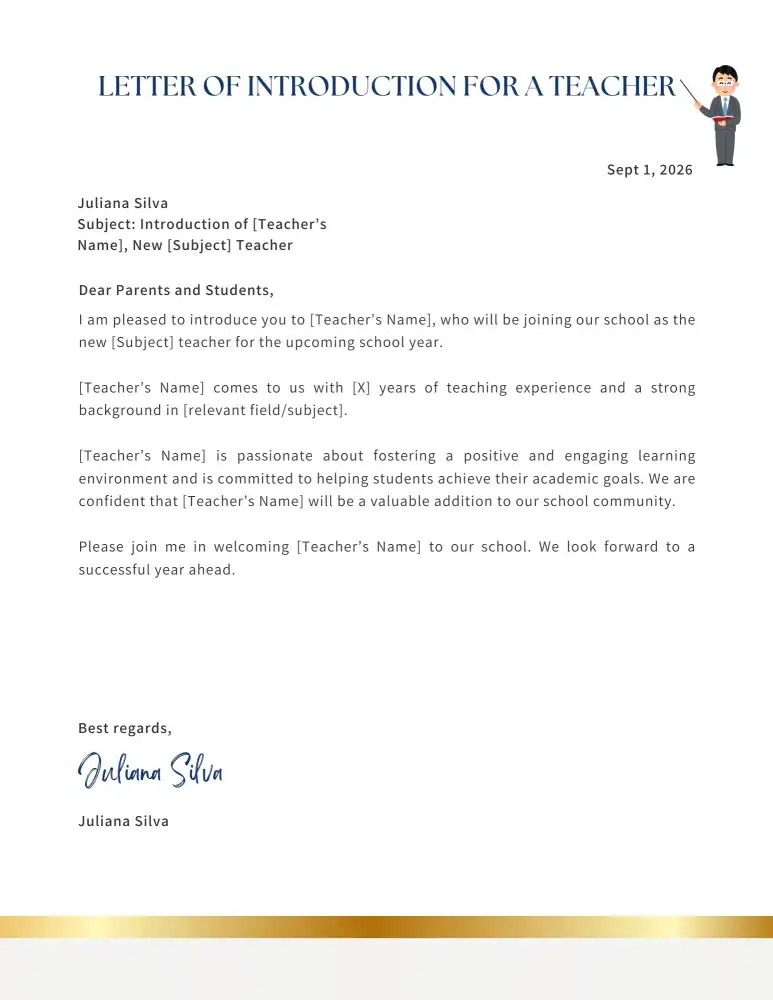
Letter of Introduction for a School
A letter of introduction for a school is often used to introduce a new school or educational program to parents, students, or the community. It highlights the school’s mission, values, and what makes it unique.
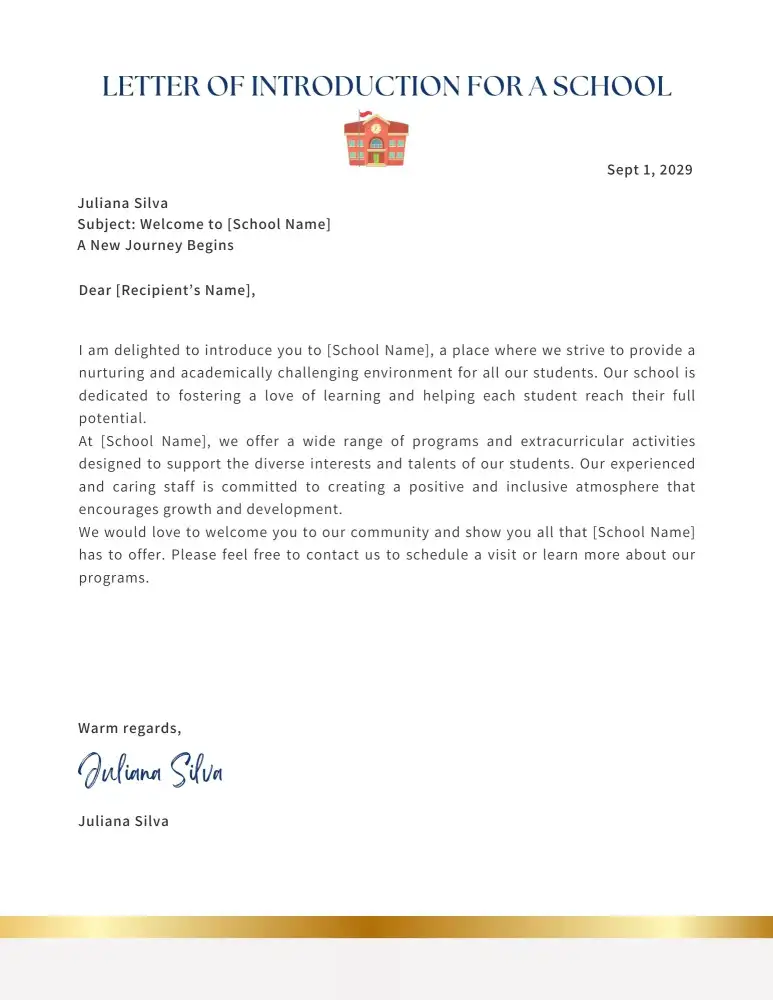
Letter of Introduction for a Business
It is to introduce the company to potential clients, partners, or investors. This letter includes details about the business’s services or products, history, and what sets it apart from competitors.
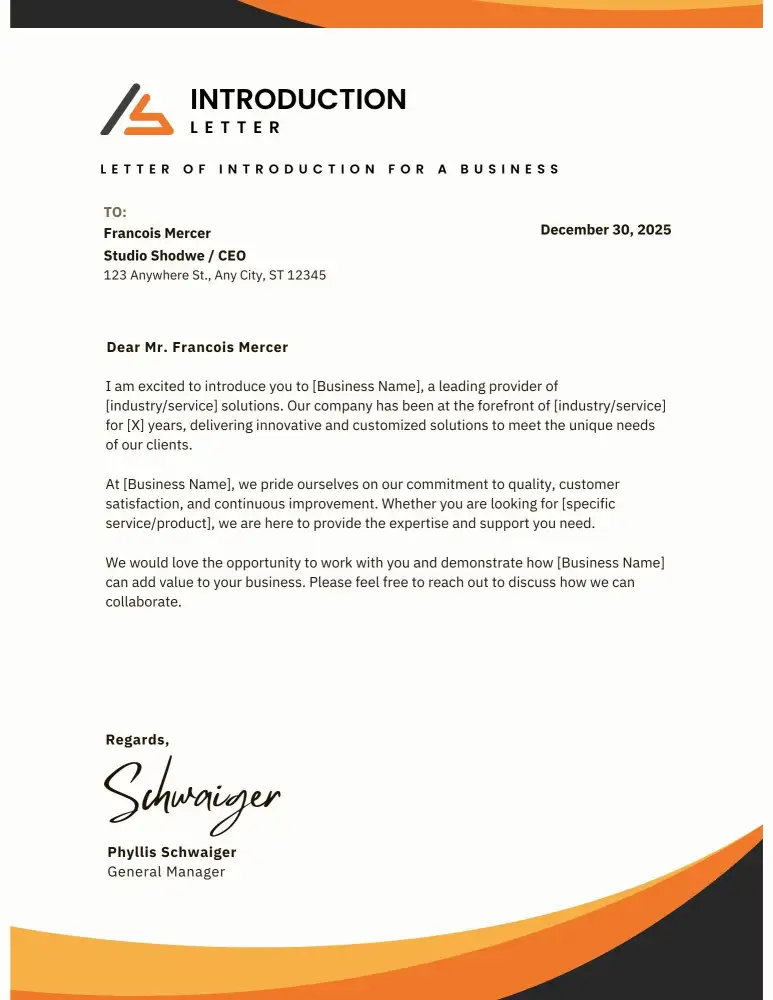
Letter of Introduction for a Job Application
A letter of introduction can accompany your resume when applying for a job. It introduces you to the employer, explains your interest in the position, and highlights your relevant skills and experiences.
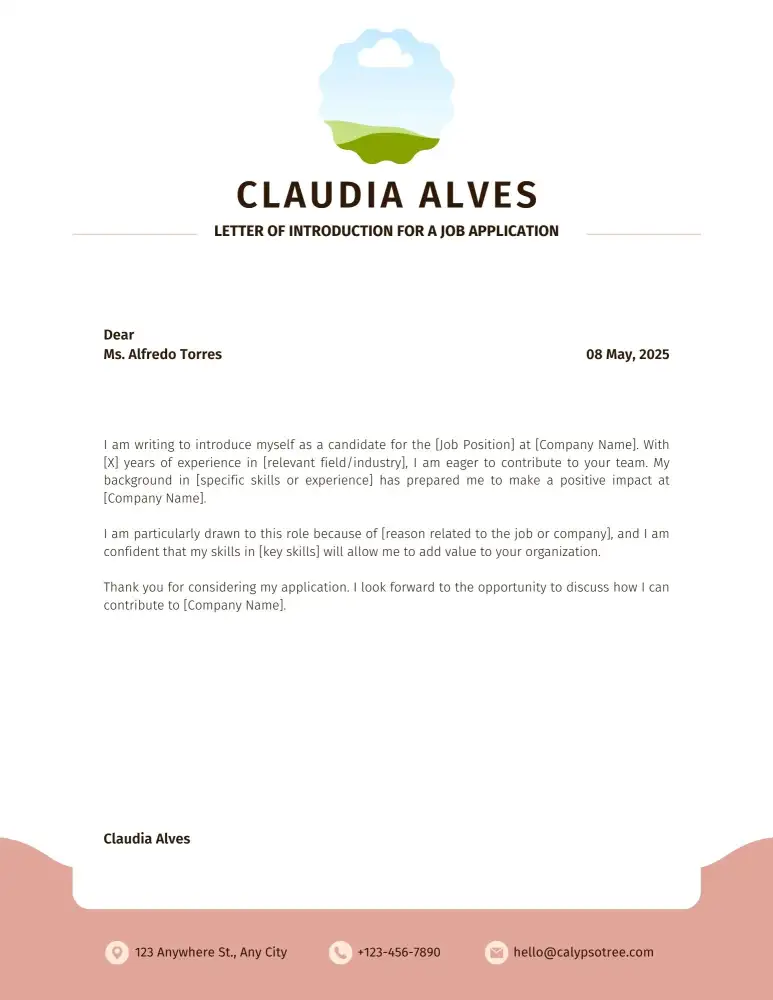
Letter of Introduction for a New Employee
This letter introduces a new employee to their coworkers or clients. It often includes the employee’s background, role in the company, and how they will contribute to the team.

Letter of Introduction for Networking
A networking letter of introduction helps you connect with professionals in your field. It’s often used to introduce yourself or someone else to a potential mentor, collaborator, or industry leader.
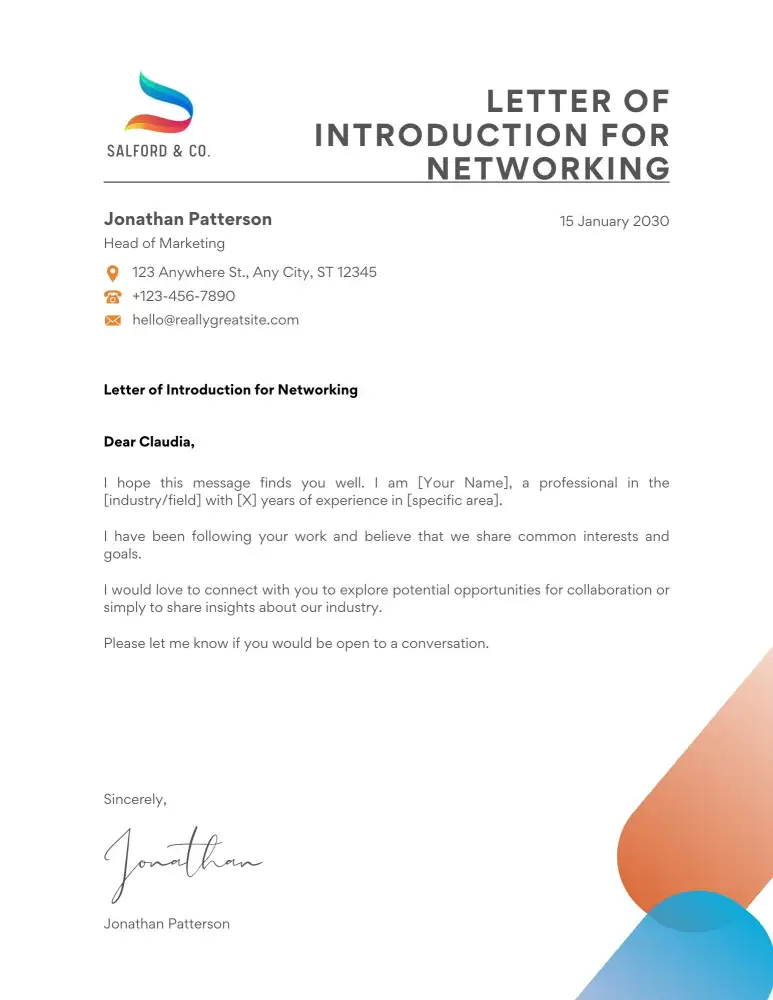
Letter of Introduction for a New Product or Service
Companies use this type of letter to introduce a new product or service to existing or potential customers. It typically includes describing the product, its benefits, and how it can meet the customer’s needs.
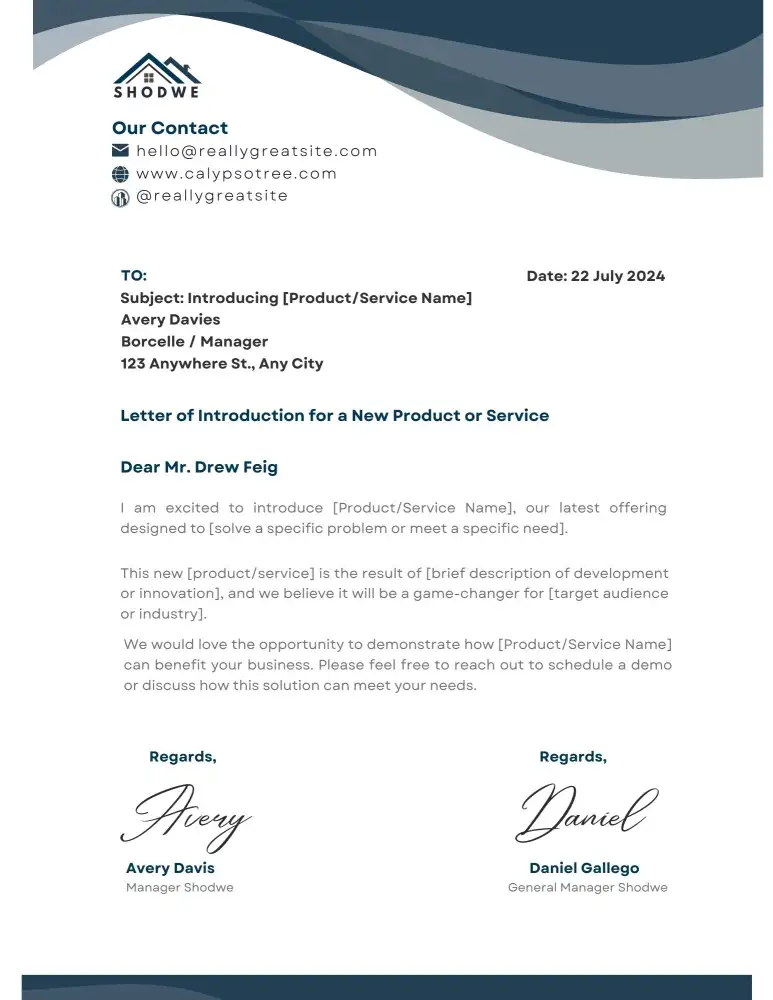
Letter of Introduction for a Volunteer Position
When applying for a volunteer position, a letter of introduction can help you stand out. It introduces you to the organization, explains your interest in volunteering, and highlights your relevant skills or experiences.
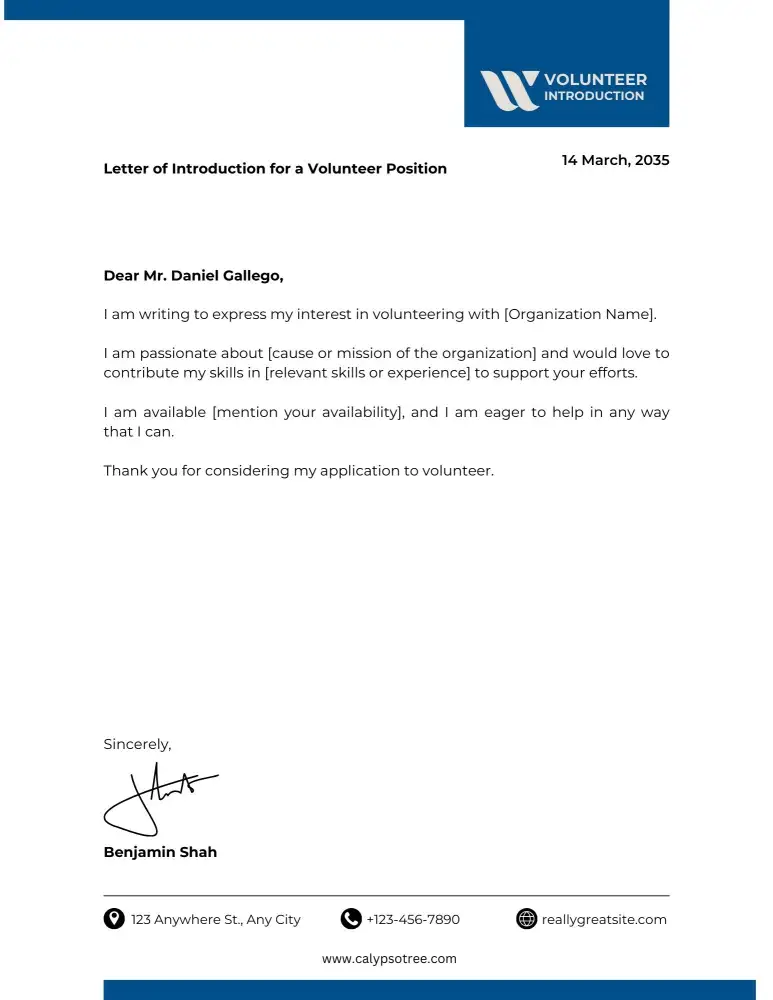
Letter of Introduction for a Real Estate Agent
Real estate agents often use introduction letters to reach out to potential clients. This letter introduces the agent, describes their experience, and explains how they can help clients buy or sell property.

Letter of Introduction for a Consultant
Consultants use introduction letters to introduce themselves to potential clients or companies. The letter typically outlines the consultant’s expertise, services offered, and how they can add value to the client’s business.
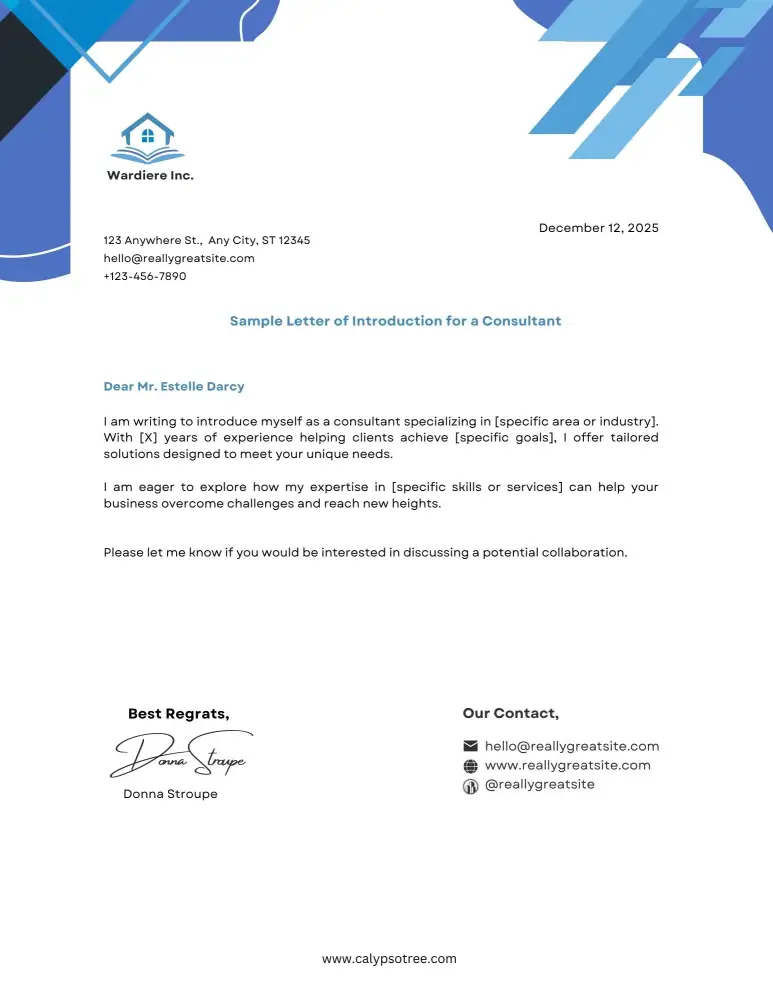
Letter of Introduction for a Contractor
Contractors use this type of letter to introduce themselves to potential clients or construction firms. It highlights their experience, past projects, and services, helping build trust and establish a working relationship.

Letter of Introduction for a Doctor or Medical Practice
Medical professionals often use introduction letters to introduce themselves to new patients or to inform the community about a new practice. This letter includes the doctor’s qualifications, areas of expertise, and what patients can expect from the practice.
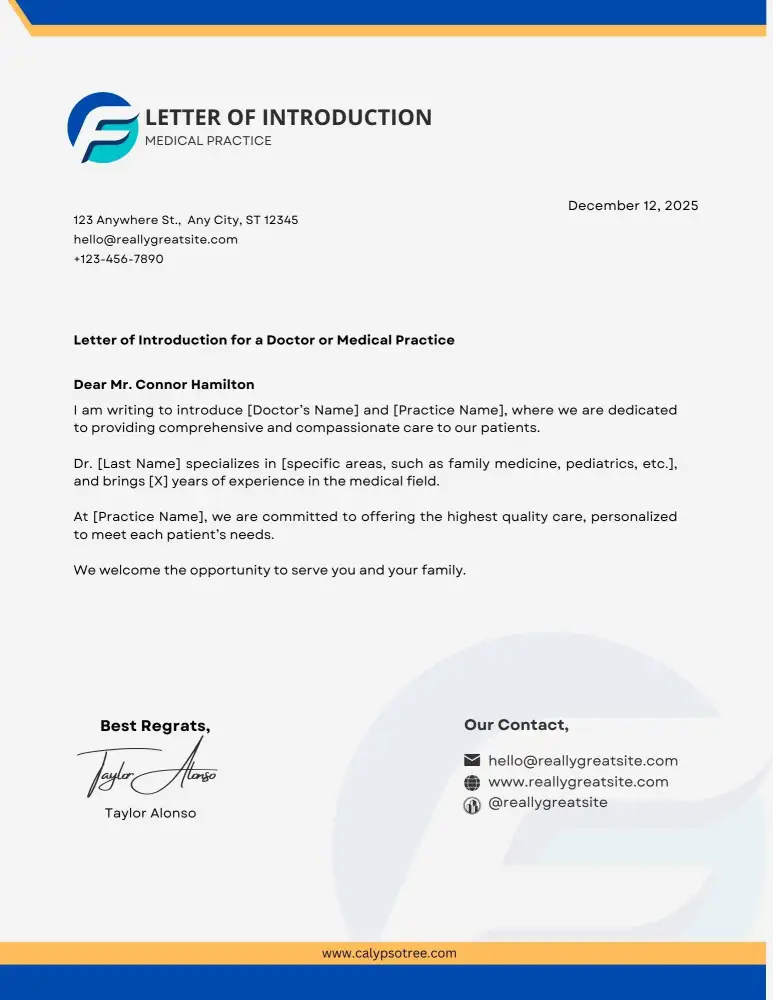
Letter of Introduction for a Politician
Politicians use introduction letters to reach voters, donors, or other politicians. This letter introduces the politician, outlines their platform or policies, and explains how they plan to serve the community.
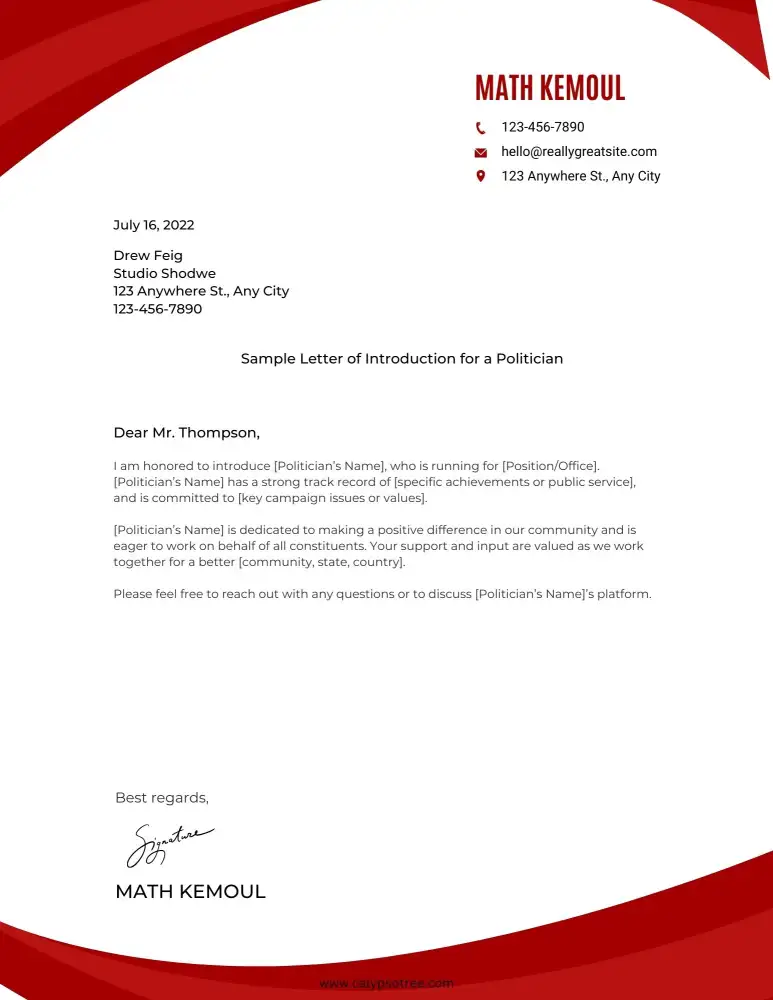
Letter of Introduction for a Nonprofit Organization
Nonprofits use introduction letters to introduce their organization to potential donors, volunteers, or partners. This letter explains the nonprofit’s mission, work, and how the recipient can get involved.
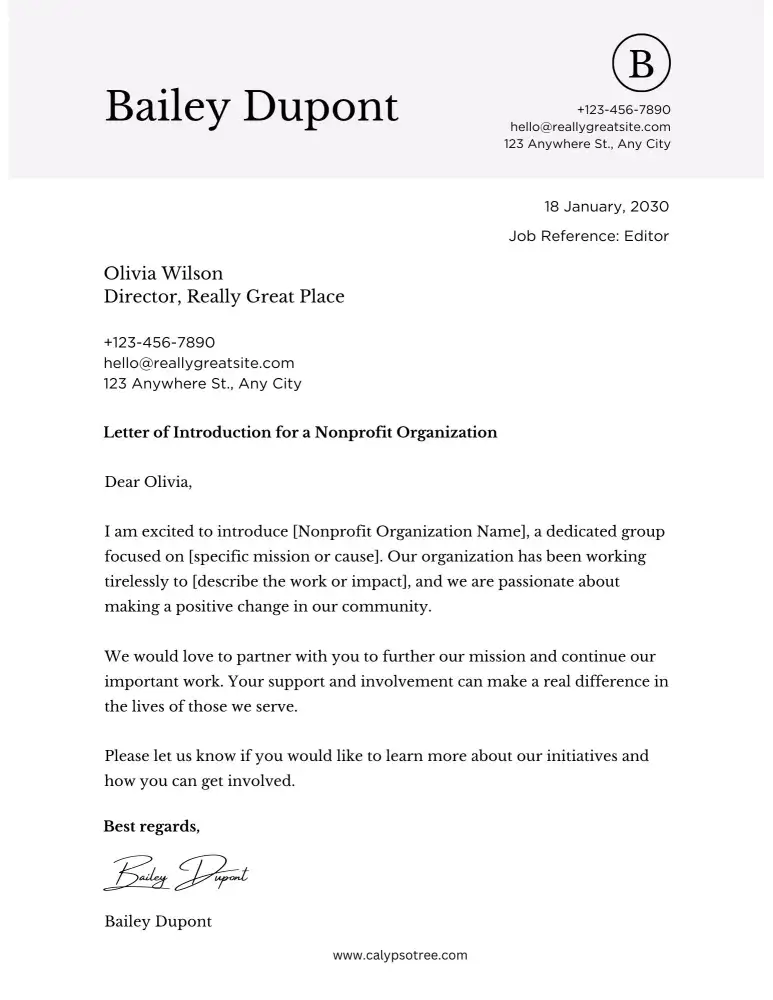
Letter of Introduction for a New Manager
When a new manager joins a team, an introduction letter can be used to introduce them to their staff. This letter usually includes the manager’s background, their leadership style, and what they aim to achieve in their new role.
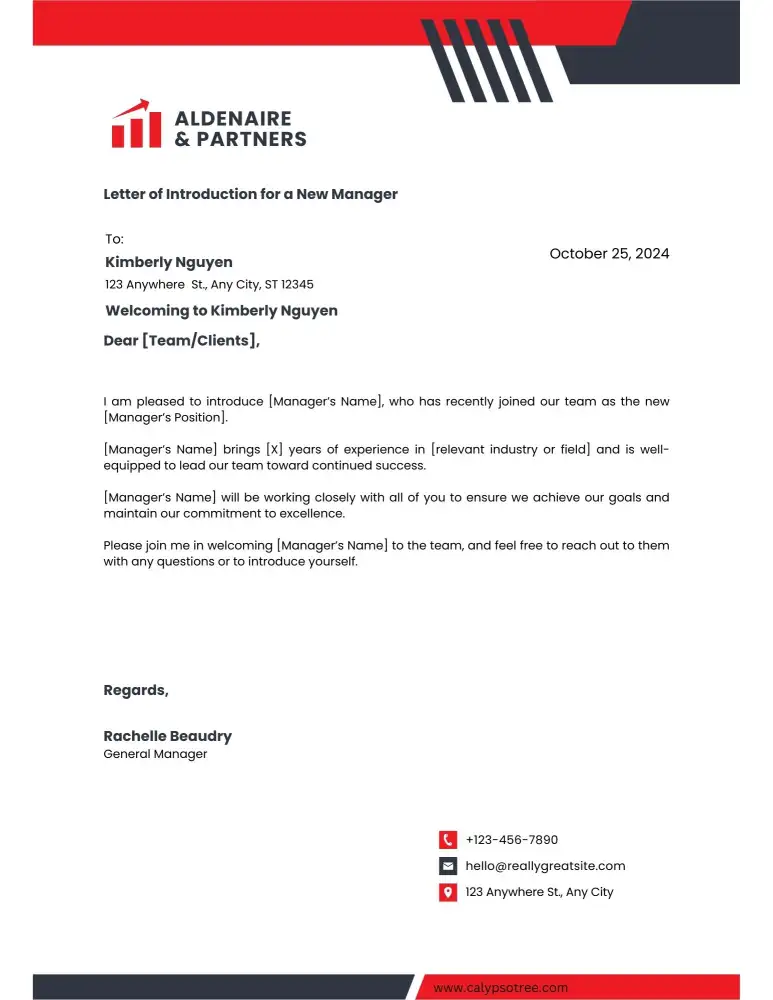
Benefits of Using a Letter of Introduction
Here are some key benefits of using a professional letter of introduction:
Makes Connections
The main purpose of a letter of introduction is to connect people who don’t know each other yet.
Builds Relationships
A letter of introduction can be the start of a new relationship.
Provides Background Information
One of the best things about a letter of introduction is that it gives background information about the person being introduced.
Sets a Professional Tone
Sending a letter of introduction shows that you take the relationship seriously and want to make a good impression.
Saves Time
A letter of introduction can save time for everyone involved. Instead of arranging a meeting or a phone call immediately, the letter allows the introduction to happen at the recipient’s convenience. They can read the letter when they have time and decide how to follow up.
Letter of Introduction Sample
FAQs About a Letter of Introduction
How long should a letter of introduction be?
It should be concise and to the point, typically one page at maximum.
Can a letter of introduction be sent via email?
Yes, the letter can be sent via email. Ensure the format is appropriate for digital communication and the subject line is clear and professional.
How do I personalize a letter of introduction?
Personalize it by mentioning specific details about the recipient or the person you are introducing, such as a recent project they worked on or how you are connected.
Can I use a template for a letter of introduction?
Yes, you can use a template for a letter of introduction. Just customize it for each recipient to ensure it feels personal and relevant.
What tone should I use in a letter of introduction?
The tone should be professional and respectful. Even if you know the recipient well, it’s important to maintain formality.
Should I follow up after sending a letter of introduction?
Yes, following up after sending it is a good practice. A follow-up shows that you are serious about the introduction and allows you to answer any questions.
Is a letter of introduction necessary for networking?
While only sometimes necessary, a letter can be handy for networking. It helps make a formal introduction and can open the door to new opportunities.
Can a letter of introduction be used to introduce a business?
It can introduce a business to potential clients, partners, or investors, help establish a connection, and provide important background information.
How do I end a letter of introduction?
End the letter with a polite closing, such as “Sincerely” or “Best regards,” followed by your name and signature.

Daniel Wilson Is a Seasoned communications professional and letter-writing expert. With over a decade of experience in corporate and non-profit sectors, Has developed a deep understanding of the power of effective communication.
Specializes in creating versatile letter templates that can be tailored to any situation. In this blog, Daniel shares a passion for the art of letter writing, offering practical tips, customizable templates, and inspiring ideas to help you communicate with clarity, confidence, and impact.






